Sustainable Green Energy Management: Optimizing Scheduling of Multi-Energy Systems Considered Energy Cost and Emission Using Attractive Repulsive Shuffled Frog-Leaping
Abstract
1. Introduction
2. Related Work
2.1. Sustainable P2G Technology Energy Management
2.2. Multi-Energy System Model
3. Proposed Method
3.1. Objective Function
3.2. Attractive Repulsive Shuffled Frog-Leaping
4. Results and Discussion
4.1. System Parameters
4.2. Analysis of Scheduling
4.3. Analysis of Collaborative Scheduling in Different Cases
5. Conclusions
Author Contributions
Funding
Institutional Review Board Statement
Informed Consent Statement
Data Availability Statement
Acknowledgments
Conflicts of Interest
Nomenclature
| Term/Variable | Description |
| MES | Multi-energy systems |
| ARSFL | Attractive Repulsive Shuffled Frog-Leaping |
| P2G | Power-to-gas |
| PSO | Particle Swarm Optimization |
| GA | Genetic Algorithm |
| MILP | Mixed-Integer Linear Programming |
| , | Output of electric energy and natural gas in the module |
| , | Input of electric energy and natural gas in the module |
| , | Input of new energy and gas storage tank |
| Stored energy of the equipment before and after gas storage or deflation | |
| , | Energy stored in or released by the gas storage tank |
| , | Gas storage and deflation efficiency |
| μ | Variable, with 1 representing the inflated state and 0 representing the deflated state |
| Coupling matrix | |
| , , | Converters for electrical output, cold output, and heat output of the module |
| , , | Allocation coefficients for electric load, electric refrigerator, and electric boiler, with the sum equal to 1 |
| Proportion coefficient for a micro-gas turbine’s natural gas consumption | |
| δ | Proportion coefficient for total heat consumed by the refrigerator |
| Refrigeration coefficient for electric refrigerator | |
| Refrigeration coefficient for lithium bromide refrigerator | |
| Heating coefficient for electric boiler | |
| Heating coefficient for steam boiler | |
| , | Micro-gas turbine’s electrical efficiency and heating coefficient |
| State of charge of the battery at time t | |
| Discharge rate of the battery itself | |
| Rated capacity of the battery | |
| , | Battery energy stored or released |
| , | Efficiency of charge and discharge |
| ci | Cost of purchasing electricity from the grid at time t |
| pit | Power purchased from the grid at time t |
| di | Cost of natural gas at time t |
| pht | Natural gas consumed for heating at time t |
| ei | Cost of hydrogen produced from P2G at time t |
| pgta | Hydrogen consumed for power generation at time t |
| fi | Cost of hydrogen stored in tanks at time t |
| pgtr | Hydrogen consumed for transportation at time t |
| gi | Cost of electricity exported to the grid at time t |
| pe | Penalty cost for not meeting the energy demand at time t |
| D(t) | Power demand at time t |
| ci | Cost of purchasing electricity from the grid at time t |
| Pit | Power purchased from the grid at time t |
References
- Mehrjerdi, H.; Saboori, H.; Jadid, S. Power-to-gas utilization in optimal sizing of hybrid power, water, and hydrogen microgrids with energy and gas storage. J. Energy Storage 2022, 45, 103745. [Google Scholar] [CrossRef]
- Kamil, M.; Ramadan, K.M.; Olabi, A.G.; Al-Ali, E.I.; Ma, X.; Awad, O.I. Economic, technical, and environmental viability of biodiesel blends derived from coffee waste. Renew. Energy 2020, 147, 1880–1894. [Google Scholar] [CrossRef]
- Abbas, E.F.; Tahseen, T.A.; Madlol, N.A.; Sulaiman, H.S.; Al-bonsrulah, H.A.Z.; Raja, V.; Al-Bahrani, M. High performance evaluation of a PV/T hybrid system connected with a thermal store unit holding paraffin wax. Int. J. Low-Carbon Technol. 2022, 17, 1158–1165. [Google Scholar] [CrossRef]
- Li, J.; Xu, W.; Feng, X.; Lu, H.; Qiao, B.; Gu, W.; Zhang, G.; Jiao, Y. Comprehensive evaluation system for optimal configuration of multi-energy systems. Energy Build. 2021, 252, 111367. [Google Scholar] [CrossRef]
- Han, D.; Lee, J.H. Two-stage stochastic programming formulation for optimal design and operation of multi-microgrid system using data-based modeling of renewable energy sources. Appl. Energy 2021, 291, 116830. [Google Scholar] [CrossRef]
- Bao, Y.; Li, R.; Yang, X.; Saini, G.; Krishna, P.R.; Wang, G. Optimal planning and multi-criteria decision making for effective design and performance of hybrid microgrid integrated with energy management strategy. Sustain. Energy Technol. Assess. 2023, 56, 103074. [Google Scholar] [CrossRef]
- Liu, Z.; Sun, Y.; Xing, C.; Liu, J.; He, Y.; Zhou, Y.; Zhang, G. Artificial intelligence powered large-scale renewable integrations in multi-energy systems for carbon neutrality transition: Challenges and future perspectives. Energy AI 2022, 10, 100195. [Google Scholar] [CrossRef]
- Nozari, M.H.; Yaghoubi, M.; Jafarpur, K.; Mansoori, G.A. Development of dynamic energy storage hub concept: A comprehensive literature review of multi storage systems. J. Energy Storage 2022, 48, 103972. [Google Scholar] [CrossRef]
- Alabi, T.M.; Agbajor, F.D.; Yang, Z.; Lu, L.; Ogungbile, A.J. Strategic potential of multi-energy system towards carbon neutrality: A forward-looking overview. Energy Built Environ. 2022, 4, 689–708. [Google Scholar] [CrossRef]
- Akulker, H.; Aydin, E. Optimal design and operation of a multi-energy microgrid using mixed-integer nonlinear programming: Impact of carbon cap and trade system and taxing on equipment selections. Appl. Energy 2023, 330, 120313. [Google Scholar] [CrossRef]
- Wang, N.; Li, B.; Duan, Y.; Jia, S. A multi-energy scheduling strategy for orderly charging and discharging of electric vehicles based on multi-objective particle swarm optimization. Sustain. Energy Technol. Assess. 2021, 44, 101037. [Google Scholar] [CrossRef]
- Dong, W.; Yang, Q.; Fang, X.; Ruan, W. Adaptive optimal fuzzy logic based energy management in multi-energy microgrid considering operational uncertainties. Appl. Soft Comput. 2021, 98, 106882. [Google Scholar] [CrossRef]
- Abdalla, A.N.; Ju, Y.; Nazir, M.S.; Tao, H. A Robust Economic Framework for Integrated Energy Systems Based on Hybrid Shuffled Frog-Leaping and Local Search Algorithm. Sustainability 2022, 14, 10660. [Google Scholar] [CrossRef]
- Taha, O.M.E.; Majeed, Z.H.; Ahmed, S.M. Artificial Neural Network Prediction Models for Maximum Dry Density and Optimum Moisture Content of Stabilized Soils. Transp. Infrastruct. Geotechnol. 2018, 5, 146–168. [Google Scholar] [CrossRef]
- Lin, Y.; Tang, X.; Fan, X. Optimization of multi-energy grid for smart stadiums based on improved mixed integer linear algorithm. Energy Rep. 2022, 8, 13417–13424. [Google Scholar] [CrossRef]
- Karimi, H.; Jadid, S.; Hasanzadeh, S. Optimal-sustainable multi-energy management of microgrid systems considering integration of renewable energy resources: A multi-layer four-objective optimization. Sustain. Prod. Consum. 2023, 36, 126–138. [Google Scholar] [CrossRef]
- Wirtz, M.; Hahn, M.; Schreiber, T.; Müller, D. Design optimization of multi-energy systems using mixed-integer linear programming: Which model complexity and level of detail is sufficient? Energy Convers. Manag. 2021, 240, 114249. [Google Scholar] [CrossRef]
- Li, X.; Yang, W.; Zhao, Z.; Wang, R.; Yin, X. Advantage of priority regulation of pumped storage for carbon-emission-oriented co-scheduling of hybrid energy system. J. Energy Storage 2023, 58, 106400. [Google Scholar] [CrossRef]
- Wu, J.; Li, B.; Chen, J.; Ding, Y.; Lou, Q.; Xing, X.; Gan, P.; Zhou, H.; Chen, J. Multi-objective optimal scheduling of offshore micro integrated energy system considering natural gas emission. Int. J. Electr. Power Energy Syst. 2021, 125, 106535. [Google Scholar] [CrossRef]
- Aghdam, F.H.; Kalantari, N.T.; Mohammadi-Ivatloo, B. A stochastic optimal scheduling of multi-microgrid systems considering emissions: A chance constrained model. J. Clean. Prod. 2020, 275, 122965. [Google Scholar] [CrossRef]
- Olivieri, Z.T.; McConky, K. Optimization of residential battery energy storage system scheduling for cost and emissions reductions. Energy Build. 2020, 210, 109787. [Google Scholar] [CrossRef]
- Patwal, R.S.; Narang, N. Multi-objective generation scheduling of integrated energy system using fuzzy based surrogate worth trade-off approach. Renew. Energy 2020, 156, 864–882. [Google Scholar] [CrossRef]
- Sedighizadeh, M.; Esmaili, M.; Jamshidi, A.; Ghaderi, M.-H. Stochastic multi-objective economic-environmental energy and reserve scheduling of microgrids considering battery energy storage system. Int. J. Electr. Power Energy Syst. 2019, 106, 1–16. [Google Scholar] [CrossRef]
- Chamandoust, H.; Derakhshan, G.; Hakimi, S.M.; Bahramara, S. Tri-objective optimal scheduling of smart energy hub system with schedulable loads. J. Clean. Prod. 2019, 236, 117584. [Google Scholar] [CrossRef]
- Li, C.; Wang, W.; Chen, D. Multi-objective complementary scheduling of hydro-thermal-RE power system via a multi-objective hybrid grey wolf optimizer. Energy 2019, 171, 241–255. [Google Scholar] [CrossRef]
- Jiang, J.; Zhang, L.; Wen, X.; Valipour, E.; Nojavan, S. Risk-based performance of power-to-gas storage technology integrated with energy hub system regarding downside risk constrained approach. Int. J. Hydrogen Energy 2022, 47, 39429–39442. [Google Scholar] [CrossRef]
- Litheko, A.; Oboirien, B.; Patel, B. Analysis of the application of power-to-gas (P2G) technology in the road transport system of South Africa. Sustain. Energy Technol. Assess. 2022, 52, 102219. [Google Scholar] [CrossRef]
- Yilmaz, H.Ü.; Kimbrough, S.O.; van Dinther, C.; Keles, D. Power-to-gas: Decarbonization of the European electricity system with synthetic methane. Appl. Energy 2022, 323, 119538. [Google Scholar] [CrossRef]
- Adewuyi, O.B.; Kiptoo, M.K.; Adebayo, I.G.; Adewuyi, O.I.; Senjyu, T. Techno-economic analysis of robust gas-to-power distributed generation planning for grid stability and environmental sustainability in Nigeria. Sustain. Energy Technol. Assess. 2023, 55, 102943. [Google Scholar] [CrossRef]
- Hou, L.; Dong, J.; Herrera, O.E.; Mérida, W. Energy management for solar-hydrogen microgrids with vehicle-to-grid and power-to-gas transactions. Int. J. Hydrogen Energy 2023, 48, 2013–2029. [Google Scholar] [CrossRef]
- Mendoza, J.M.F.; Ibarra, D. Technology-enabled circular business models for the hybridisation of wind farms: Integrated wind and solar energy, power-to-gas and power-to-liquid systems. Sustain. Prod. Consum. 2023, 36, 308–327. [Google Scholar] [CrossRef]
- Bailera, M.; Peña, B.; Lisbona, P.; Romeo, L.M. Decision-making methodology for managing photovoltaic surplus electricity through Power to Gas: Combined heat and power in urban buildings. Appl. Energy 2018, 228, 1032–1045. [Google Scholar] [CrossRef]
- Nazir, M.S.; Abdalla, A.N.; Wang, Y.; Chu, Z.; Jie, J.; Tian, P.; Jiang, M.; Khan, I.; Sanjeevikumar, P.; Tang, Y. Optimization configuration of energy storage capacity based on the microgrid reliable output power. J. Energy Storage 2020, 32, 101866. [Google Scholar] [CrossRef]
- Abdalla, A.N.; Ali, O.M.; Awad, O.I.; Tao, H. Wavelet analysis of an SI engine cycle-to-cycle variations fuelled with the blending of gasoline-fusel oil at a various water content. Energy Convers. Manag. 2019, 183, 746–752. [Google Scholar] [CrossRef]
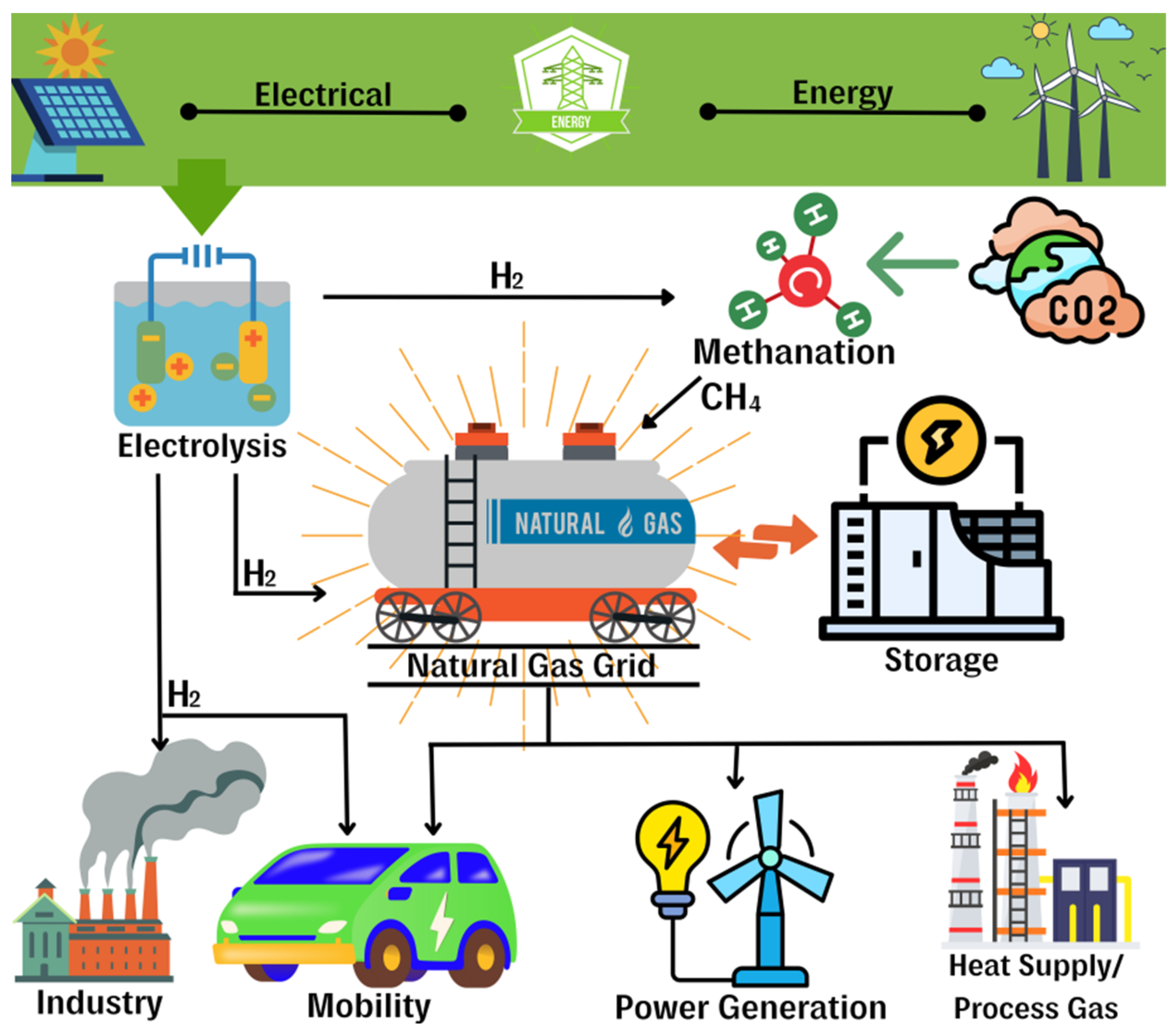
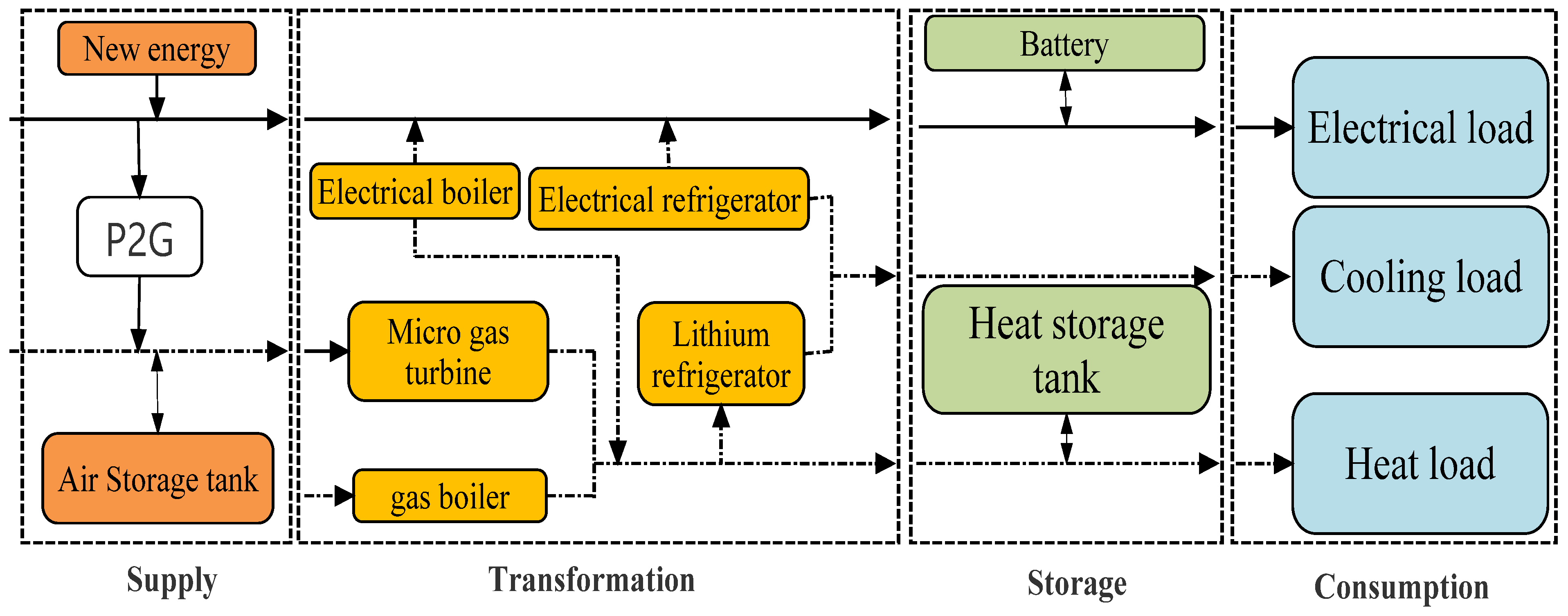

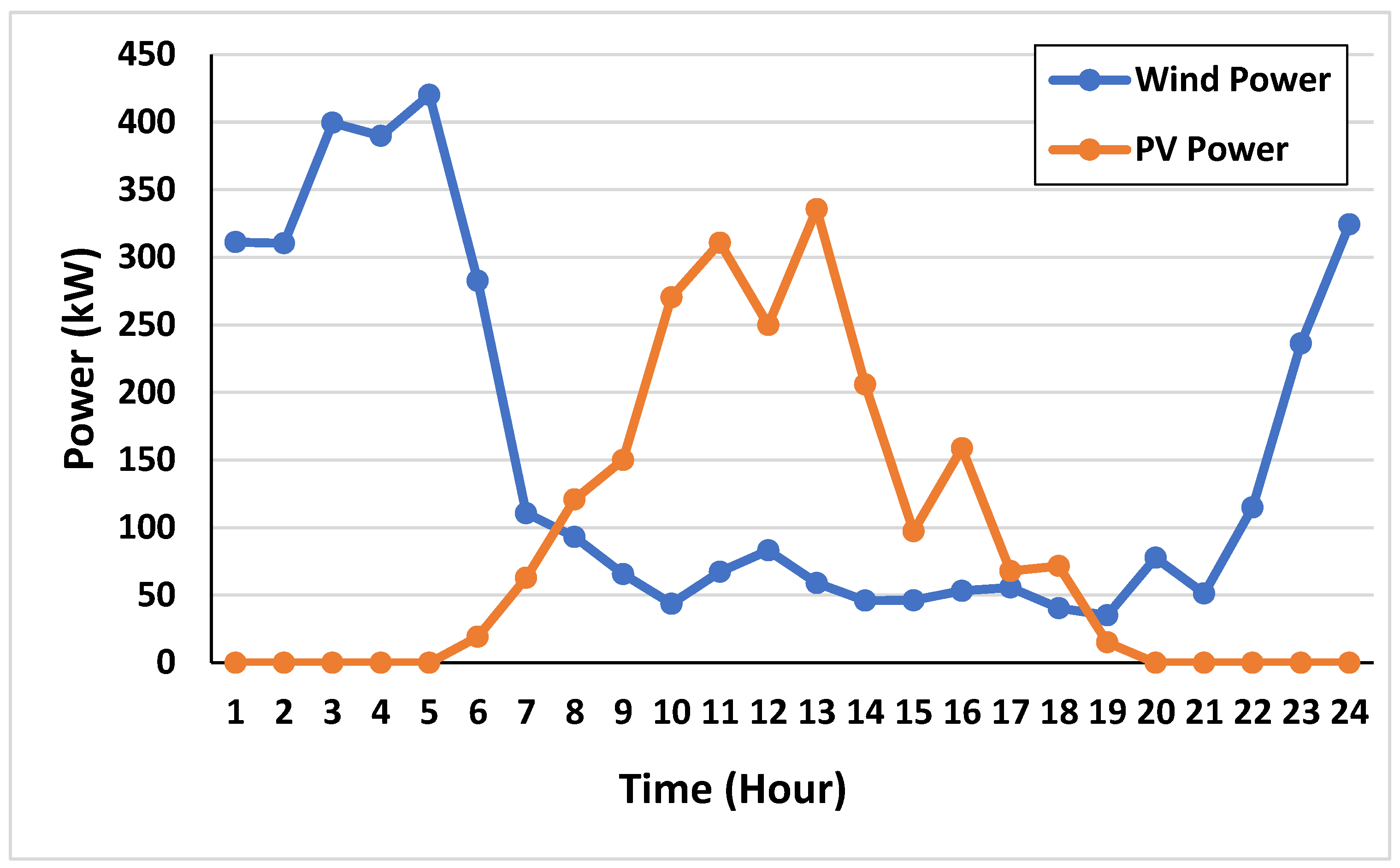
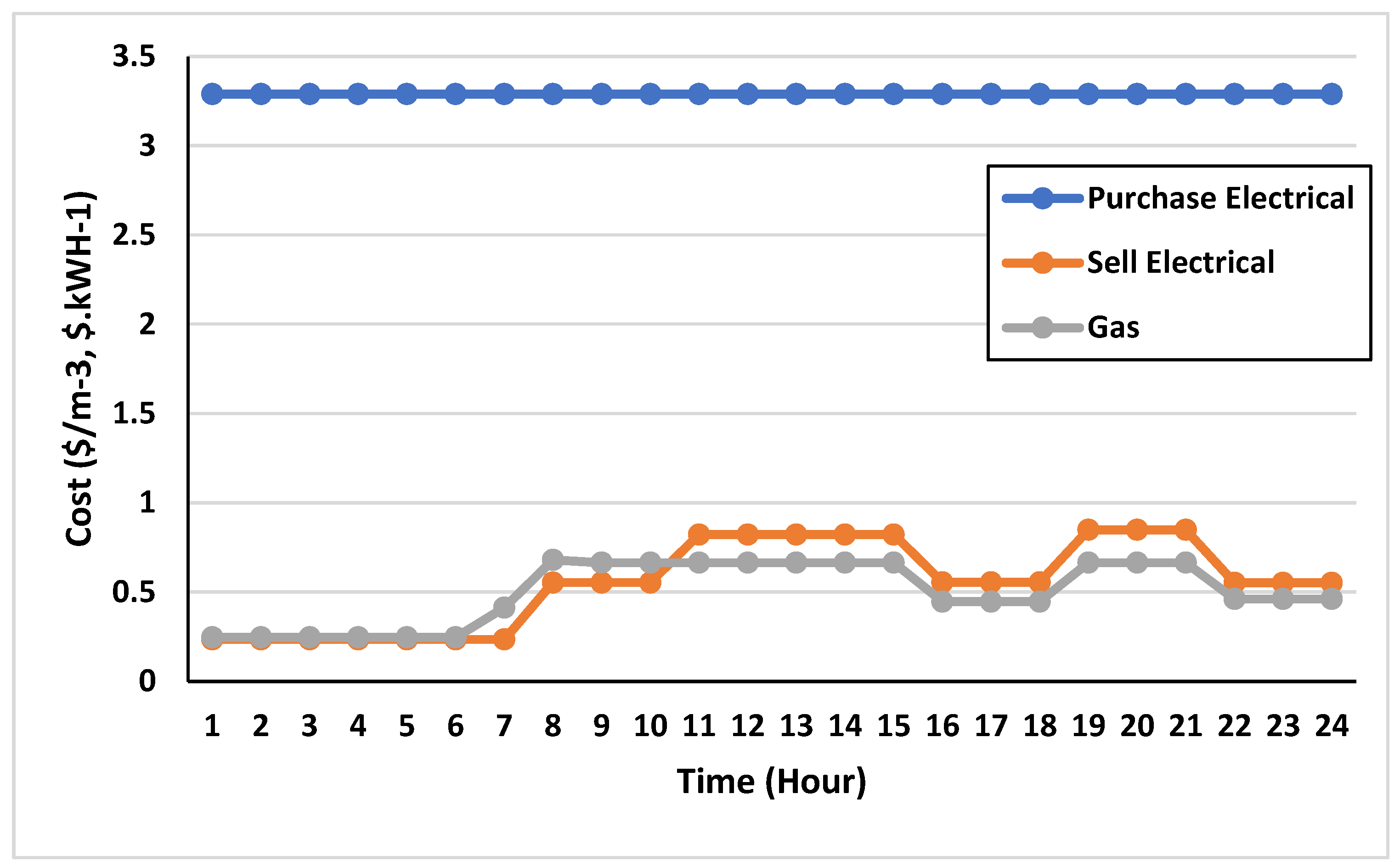
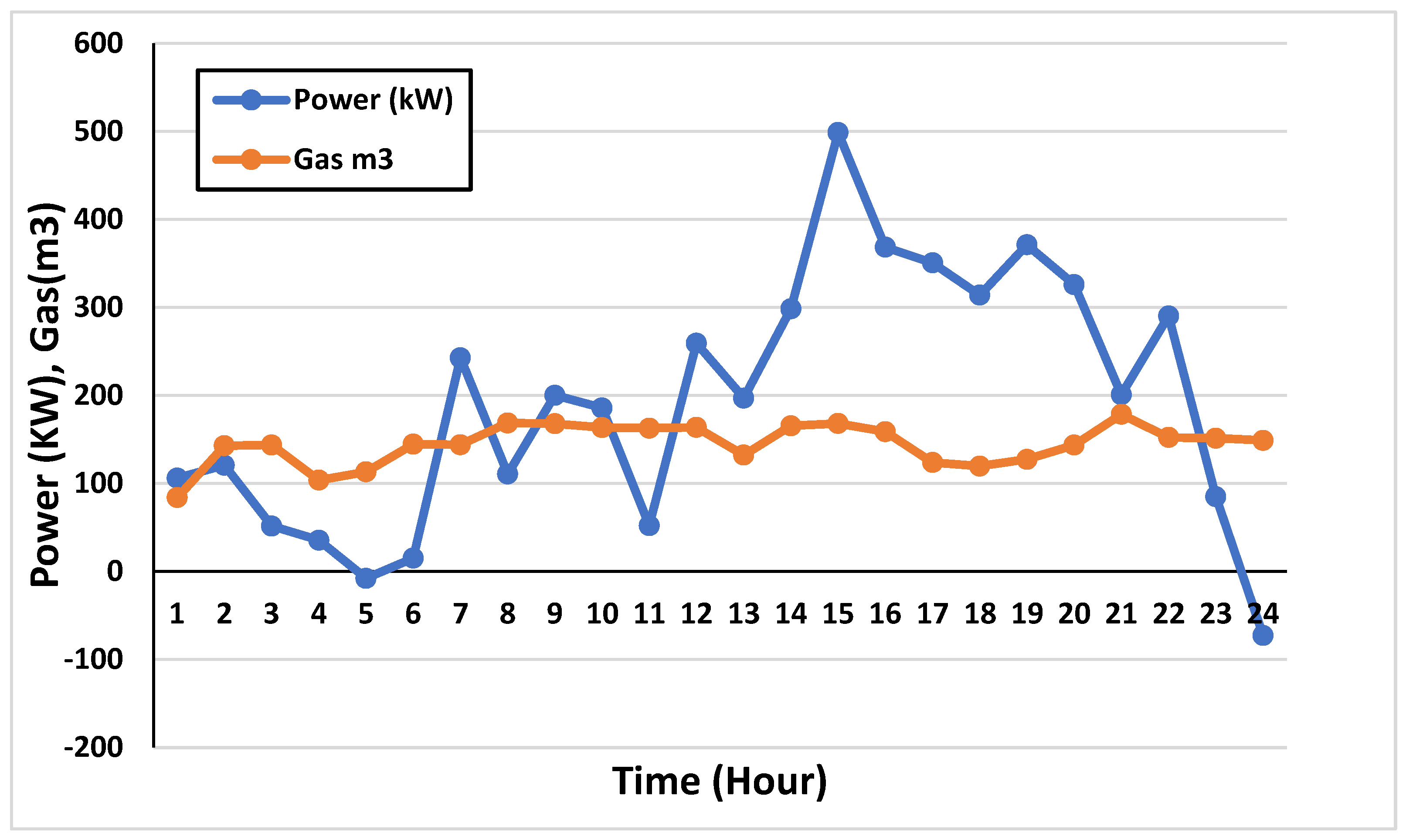
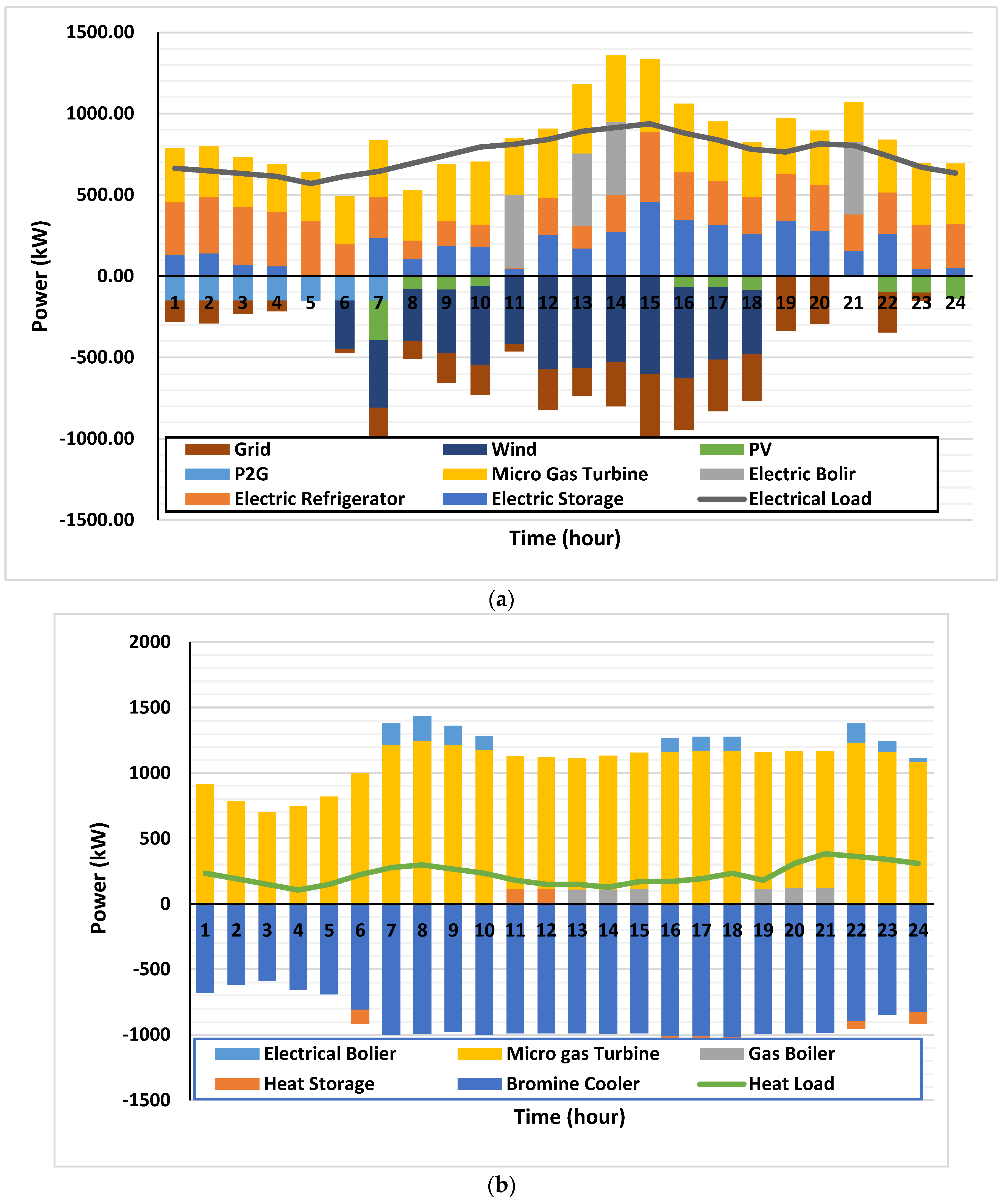



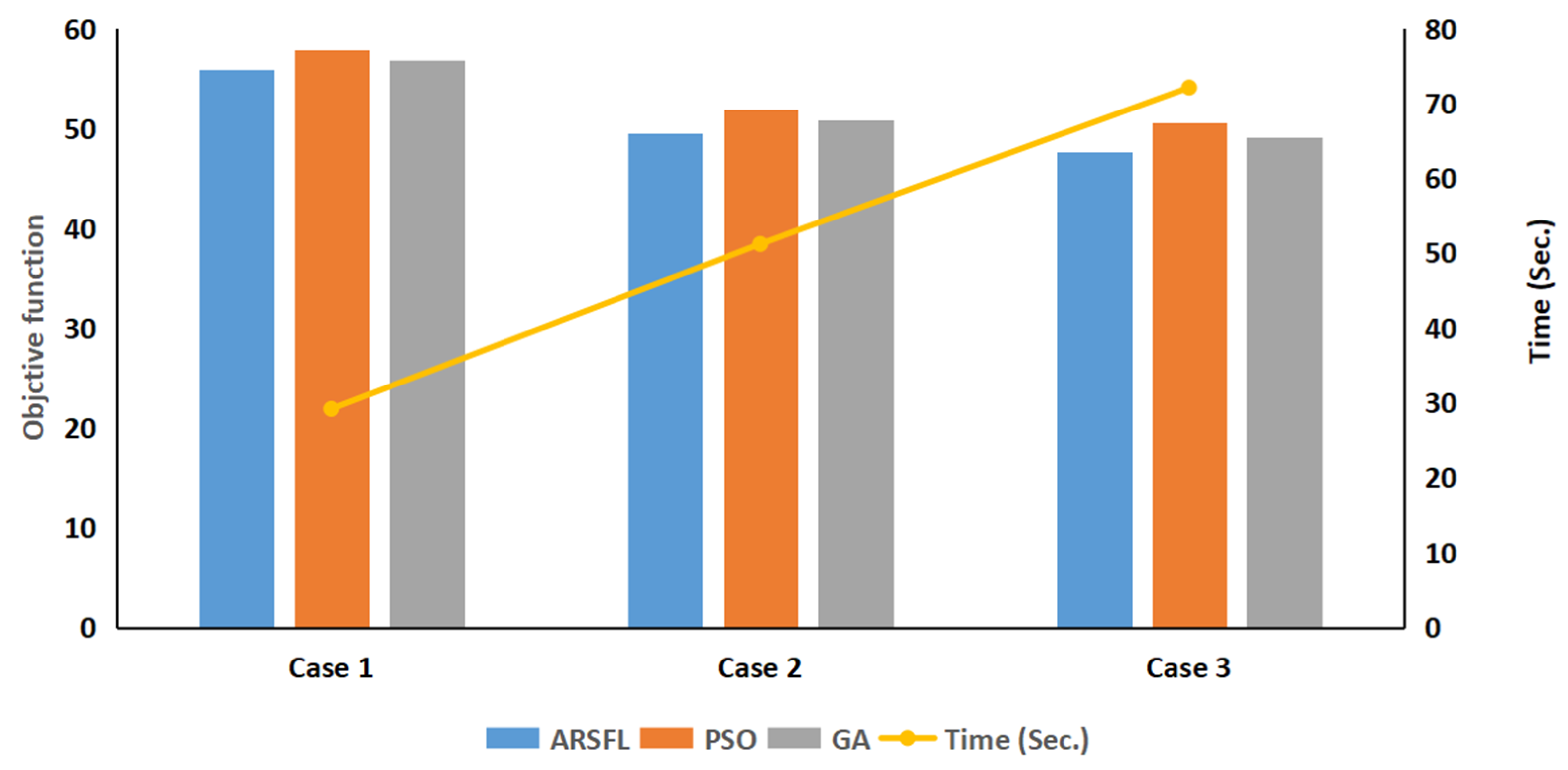
| Part | Equipment | Efficiency Factor |
|---|---|---|
| Supply | P2G | 0.6 |
| Gas tank | 0.95 | |
| Conversion | Bromine cooler | 1.38 |
| Electric refrigerator | 3 | |
| Electric boiler | 3 | |
| Gas boiler | 7.92 | |
| Micro gas engine | 6.65 | |
| Storage | Battery | 0.95 |
| Thermal storage tank | 0.95 |
| Module | Case 1 | Case 2 | Case 3 |
|---|---|---|---|
| Consumption module | √ | √ | √ |
| Conversion module | √ | √ | √ |
| Supply module | × | √ | √ |
| Storage module | × | × | √ |
| Dispatch cost/USD | 2774.91 | 2345.41 | 2238.47 |
Disclaimer/Publisher’s Note: The statements, opinions and data contained in all publications are solely those of the individual author(s) and contributor(s) and not of MDPI and/or the editor(s). MDPI and/or the editor(s) disclaim responsibility for any injury to people or property resulting from any ideas, methods, instructions or products referred to in the content. |
© 2023 by the authors. Licensee MDPI, Basel, Switzerland. This article is an open access article distributed under the terms and conditions of the Creative Commons Attribution (CC BY) license (https://creativecommons.org/licenses/by/4.0/).
Share and Cite
Kadirgama, K.; Awad, O.I.; Mohammed, M.N.; Tao, H.; Bash, A.A.H.K. Sustainable Green Energy Management: Optimizing Scheduling of Multi-Energy Systems Considered Energy Cost and Emission Using Attractive Repulsive Shuffled Frog-Leaping. Sustainability 2023, 15, 10775. https://doi.org/10.3390/su151410775
Kadirgama K, Awad OI, Mohammed MN, Tao H, Bash AAHK. Sustainable Green Energy Management: Optimizing Scheduling of Multi-Energy Systems Considered Energy Cost and Emission Using Attractive Repulsive Shuffled Frog-Leaping. Sustainability. 2023; 15(14):10775. https://doi.org/10.3390/su151410775
Chicago/Turabian StyleKadirgama, Kumaran, Omar I. Awad, M. N. Mohammed, Hai Tao, and Ali A. H. Karah Bash. 2023. "Sustainable Green Energy Management: Optimizing Scheduling of Multi-Energy Systems Considered Energy Cost and Emission Using Attractive Repulsive Shuffled Frog-Leaping" Sustainability 15, no. 14: 10775. https://doi.org/10.3390/su151410775
APA StyleKadirgama, K., Awad, O. I., Mohammed, M. N., Tao, H., & Bash, A. A. H. K. (2023). Sustainable Green Energy Management: Optimizing Scheduling of Multi-Energy Systems Considered Energy Cost and Emission Using Attractive Repulsive Shuffled Frog-Leaping. Sustainability, 15(14), 10775. https://doi.org/10.3390/su151410775








